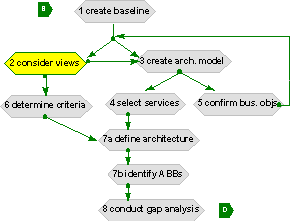 Objective
ObjectiveObjective Approach Inputs Activities Outputs
 Objective
ObjectiveThe objective of this step is to perform an analysis of the target architecture from a number of different concerns (requirements) or viewpoints and to document each relevant viewpoint. The purpose of considering these viewpoints is to ensure that all relevant stakeholder concerns will have been considered in the final target architecture, so ensuring that the target system will meet all the requirements put on it.
The Business Architecture is used to select the most relevant viewpoints for the project. It is important to recognize that in practice it will be rarely possible to reach 100% coverage of stakeholder concerns.
Pertinent viewpoints are created first from the existing system to identify the salient elements of the current systems requirements that the stakeholders confirm must also be satisfied in the target system. A comprehensive set of stakeholder viewpoints must also be created for the target system. The corresponding views of the existing system will be compared with the views of the target system to identify elements of the existing system that are intended for replacement or improvement.
If a set of viewpoints is carefully chosen, it will expose the most important aspects of the existing architecture and the requirements of the target system.
Several different viewpoints may be useful. Architecture viewpoints and views are described in greater detail in Part IV, Architecture Views. The viewpoints presented there should not be considered an exhaustive set, but simply as a starting point. In developing an architecture, it is very likely that some of the viewpoints given there will not be useful, while others not given there will be essential. Again use the Business Architecture as a guide in selecting the pertinent viewpoints.
The inputs to this step are:
Key activities in this step include:
The outputs of this step are:
Step 3: Create architectural model of building blocks
Copyright © The Open Group, 1998, 1999, 2000, 2001